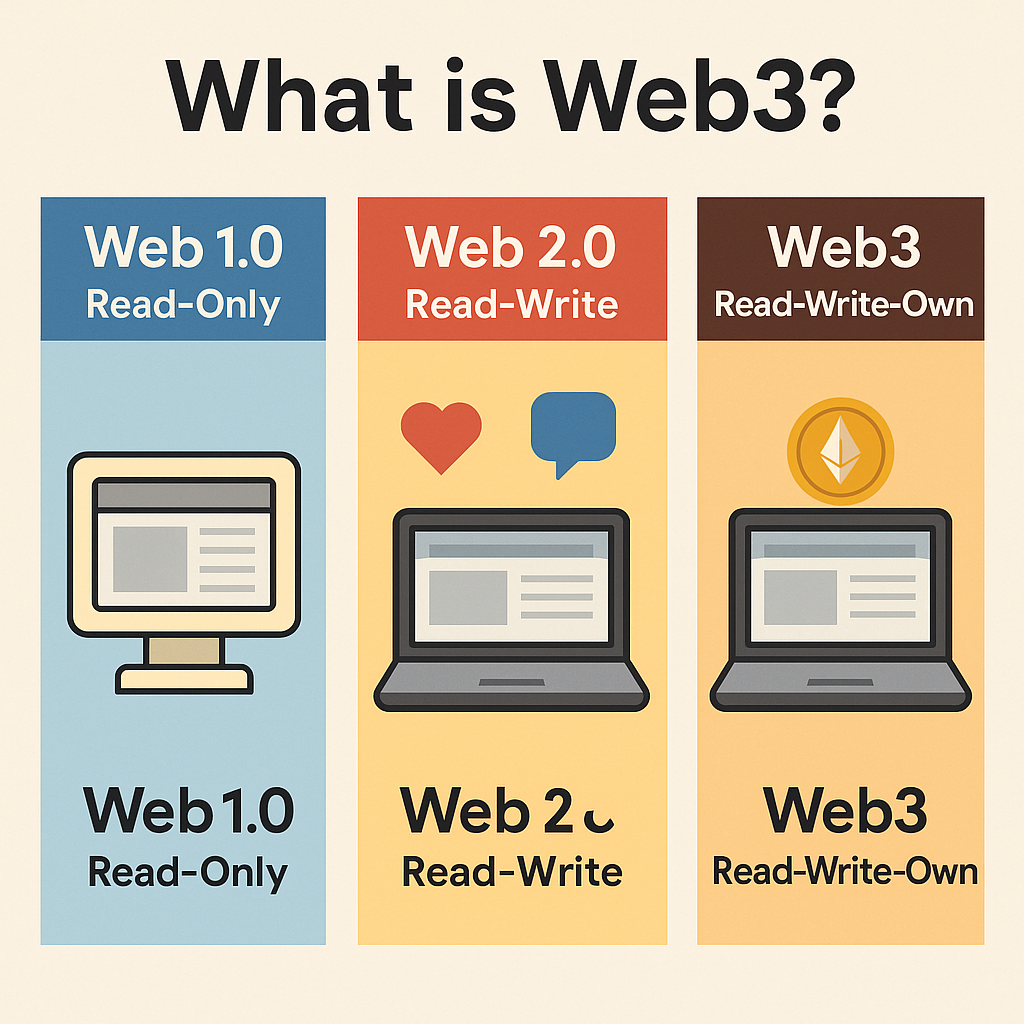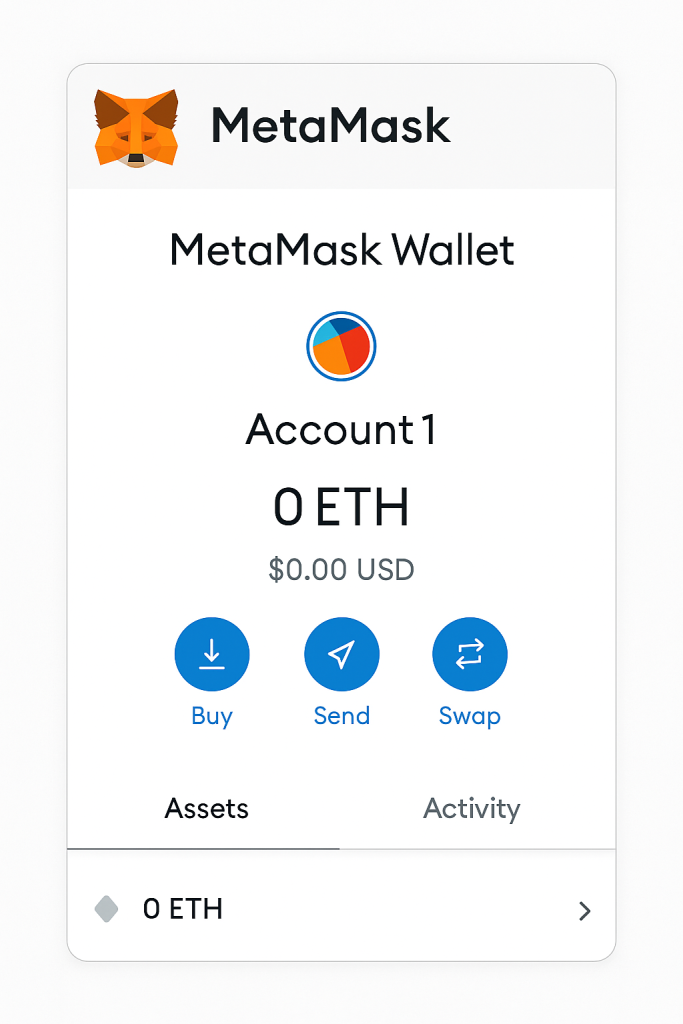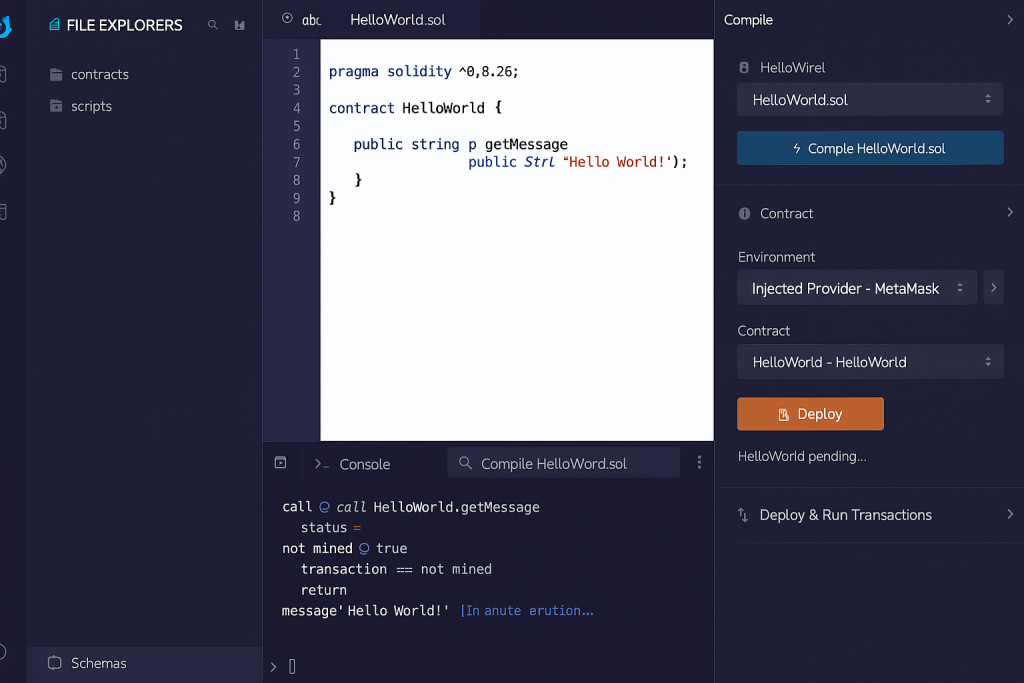Introduction
As we approach 2025, Web3 technology is transforming the internet. From payments to digital identities and decentralized storage, the emergence of dApps (decentralized applications) is opening up new avenues for developers, entrepreneurs, and creators. Yet, if you’re a beginner in Web3, it could be intimidating.
This blog is for beginners who would love to get up to speed quickly on the Web3 ecosystem and build their own dApp in one day — with little or no coding. We’ll guide you through the basic tools, platforms, and steps, in easy-to-understand terms.
Whether a future blockchain developer, startup founder, or simply interested, this tutorial will bring Web3 within reach and doing so.
What is Web3?
Understanding the Evolution :

- Web1 (Static Web) – Read-only, information websites.
- Web2 (Interactive Web) – Social media, apps, user-generated content.
- Web3 (Decentralized Web) – Ownership, smart contracts, blockchain, and user privacy.
Web3 is decentralization. It eliminates intermediaries so people can interact directly peer-to-peer and own their data, identities, and digital assets.
Key Concepts:
- Blockchain: A public, immutable ledger.
- Smart Contracts: Self-executing code that resides on the blockchain.
- dApps: Applications that execute on a blockchain network rather than centralized servers.
- Wallets: Digital wallets are used to sign transactions and communicate with dApps.
Why Build a dApp?
There are some strong reasons to consider building dApps :
- No central authority: You don’t have a hosting provider, app store, or centralized service in your way.
- Global accessibility: Anyone who has a wallet and access to the internet can access your dApp.
- Security and transparency: Blockchain renders transactions and logic traceable and permanent.
- Monetization: Tokenomics, NFTs, or decentralized subscriptions.
- Developer innovation: Remix open-source smart contracts, fork successful dApps, and iterate quicker.
Overview of Tools You’ll Use
- MetaMask: Wallet for blockchain interaction
- Remix IDE: Developing smart contracts
- ThirdWeb: No-code contract deployment + SDK
- Alchemy : Blockchain API & node provider
- IPFS: Decentralized storage
- Fleek: Decentralized hosting
- Vercel/Netlify: Optional frontend deployment

Setting Up Your Web3 Environment
Step 1: Install MetaMask
MetaMask is a free browser extension that serves as your Web3 wallet.
To get started, download MetaMask from the official MetaMask website. It’s available as a browser extension for Chrome, Firefox, and Brave.
- Visit MetaMask.io
- Download the Chrome/Brave/Firefox extension
- Generate a new wallet

- Store your seed phrase safely (DO NOT share)
- Link it to a testnet (e.g., Goerli or Sepolia) for free testing
Why MetaMask?
MetaMask is one of the most supported wallets in the ecosystem. It is easy to use with most Web3 platforms, supports custom RPCs, and is great for beginners.
Step 2: Get Testnet ETH
You’ll need ETH to pay gas fees when deploying contracts or interacting with the blockchain.
- Use a faucet like https://goerlifaucet.com/
- Paste your MetaMask wallet address and receive test ETH
Additional Testnet Tips:
- Use multiple faucets if one fails
- Monitor transactions at etherscan.io
Step 3: Explore Remix IDE
Remix is a browser-based IDE for writing and deploying Solidity smart contracts.
Use the Remix Ethereum IDE to write, compile, and deploy smart contracts directly from your browser.
- Visit Remix.ethereum.org
- Choose a Solidity template (like “Hello World”)
- Paste the code, compile it, and deploy via MetaMask

Benefits of Remix IDE:
- Real-time Solidity compiler
- In-built debugger
- Console output for calls to smart contracts
Optional: Utilize ThirdWeb for no-code setup or premium contract templates.
Step 4: Utilize ThirdWeb for No-Code Deployment
- Go to https://thirdweb.com
- Link your MetaMask wallet
- Choose templates: NFT drops, marketplace, tokens, governance
- Personalize settings such as supply, royalties, and minting conditions
- Deploy directly to blockchain in minutes
- Utilize generated SDK to integrate frontend
Step 5: Create Your Frontend (React)
Using React:
React is popular for building Web3 dApps due to its component-based structure and speed.
- npx create-react-app my-dapp
- cd my-dapp
- npm install @thirdweb-dev/react ethers
Basic Integration:
import { ThirdwebProvider } from “@thirdweb-dev/react”;
function MyApp() {
return (
<ThirdwebProvider activeChain=”goerli”>
<ConnectWallet />
{/* Your dApp UI */}
</ThirdwebProvider>
);
}
Connect Wallet Button:
import { useMetamask, useAddress } from “@thirdweb-dev/react”;
function ConnectWallet() {
const connectWithMetamask = useMetamask();
const address = useAddress();
return (
<button onClick={connectWithMetamask}>
{address? `Connected: ${address.slice(0, 6)}…` : “Connect Wallet”}
</button>
);
}
Step 6: Hosting the Frontend
Fleek (Web3 Native Hosting):
- GitHub integration for CI/CD
- Built-in ENS support
It uses IPFS under the hood
Netlify/Vercel (Web2 Meets Web3):
- Blazing fast frontend hosting
- Custom domains, analytics, and CI/CD
- Easy GitHub integration
Real-Life Use Cases of dApps
1. DeFi Protocols
- Uniswap: Swap tokens on-chain with no central exchange
- Aave: Borrow/lend without banks
2. NFTs and Collectibles
- Zora: Creator-focused NFT platform
- Foundation: Curated art marketplaces for artists

3. Gaming
- Gods Unchained: Free-to-play card game with true ownership
- Decentraland: Virtual world where users buy land with crypto
4. Social & Identity
- Farcaster: Decentralized Twitter alternative
- ENS: Get a human-readable address like you.eth
Tips for Beginners
- Bookmark faucets, testnet explorers, and deployment platforms
- Learn Ethers.js or Wagmi for deeper frontend integration
- Join communities (ThirdWeb Discord, Buildspace, Gitcoin)
- Always test thoroughly on testnets
- Understand the cost implications when moving to mainnet
Going Beyond the Basics — Powering Up Your Web3 dApp
1. Advanced Smart Contract Interactions
Advanced contracts let your app:
- Allow staking or minting based on certain conditions
- Auto-distribute rewards or fees
- Update metadata and token logic post-deployment
Tools:
- ThirdWeb Custom Contracts
- Hardhat or Foundry if you want more flexibility
- Example: Create a staking contract where users lock tokens for rewards, with real-time tracking using events.
2. Token Gating & Role-Based Access
Token gating allows access to certain features based on wallet holdings. Common in:
- NFT communities
- Exclusive content platforms
- Web3 e-commerce
Using ThirdWeb SDK, you can:
- Check if a user owns a specific NFT or token
- Grant access to premium routes/pages
Code Sample:
import { useContract, useNFTBalance } from “@thirdweb-dev/react”;
const { contract } = useContract(“<your_contract_address>”);
const { data: nftBalance } = useNFTBalance(contract, address);
if (nftBalance?.gt(0)) {
// Show gated content
}
3. Web3 Login (Sign-In with Ethereum – SIWE)
Instead of using email/password, allow users to authenticate using their wallet.
- More secure
- Frictionless UX
- Fully decentralized
Use SIWE (Sign-In with Ethereum) libraries like:
- Web3Modal + warm
- NextAuth.js + ethers.js integration
- Bonus: Use SIWE to create role-based dashboards or save settings securely.
4. Web3 Analytics Tools
Track wallet activity, contract interactions, or feature usage:
- Dune Analytics – Create dashboards from on-chain data
- Tenderly – Monitor contract calls and alerts
- Blocknative – Real-time transaction tracking
Conclusion
Launching a Web3 dApp in one day is more achievable than ever in 2025. The ecosystem has matured with beginner-friendly tools and services that reduce the complexity of smart contracts, storage, and hosting.
Whether you want to build an NFT project, a DAO, or a tokenized product, you now have the knowledge to set the foundation. As with any skill, consistency, and curiosity will take you further.
The possibilities with Web3 are only just beginning. Whether you’re building for fun, education, or a business idea — you now have the tools to make it real.
Stay consistent, explore open-source projects, and share your builds with the community. Web3 is still young, and every great project starts with a first step — yours starts today
If you’re interested in turning your Web3 or tech skills into income, don’t miss our guide on AI Side Hustles of 2025. It’s packed with actionable ideas you can start today.



